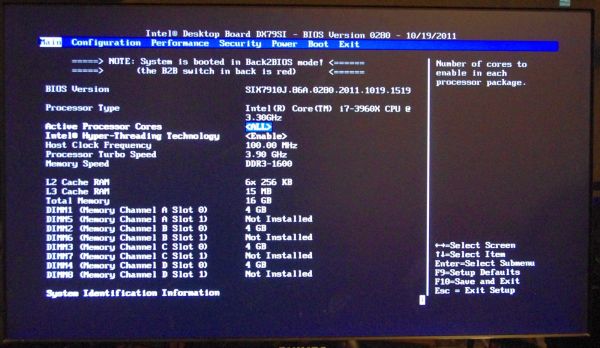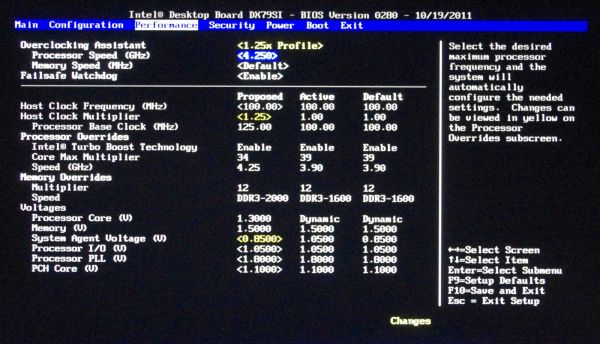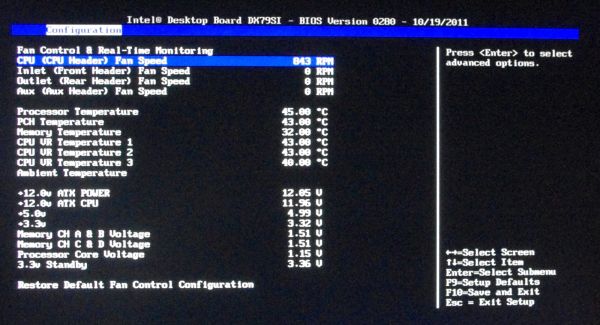Intel DX79SI Review: The Default X79?
by Ian Cutress on November 18, 2011 1:10 AM EST- Posted in
- Motherboards
- Intel
- X79
BIOS
Having not personally delved into an Intel motherboard BIOS for quite a while, it was going to be interesting to see their take on the grand cityscape of graphical BIOS opportunities. As I postulated earlier, it is hard to gauge just how much time, effort and people Intel put in this department, given they are more in the market for selling processors and chipsets. The answer to this could be considered straightforward after booting into their BIOS.
Do not expect much in the way of graphics, unless you have a penchant for ASCII art. However the first screen does contain a lot of info that other motherboard manufacturers do not bother to show right off the bat – BIOS version, processor, speed, frequency, memory and memory speed. In the best graphical implementations on other products we also get fan speeds and voltage quick reference values, so there is definitely room for improvement here.
The primary screen of interest however is the performance section for overclocking. Right at the top is the Overclocking Assistant, where the user can select either a 1.00x or 1.25x gear ratio (I’ve heard that only 1% of CPUs can do a 1.66x ratio, so there’s method in limiting it to 1.25x here), which creates a processor speed menu underneath for selecting an optimum CPU speed. These are sets of predefined CPU values pre-programmed into the BIOS, so your mileage may vary – make sure there is sufficient cooling at hand. I will go through these options later in the overclocking section.
What’s odd about this menu is that the ‘Processor Overrides’ and ‘Memory Overrides’ sections are actually expandable into new screens of options – this isn’t immediately obvious when you first look at it. The processor related screen deals with voltage, V-Droop, Turbo Boosts technology and power limits, whereas the memory configuration is where we deal with XMP and sub-timings. If you have manually overclocked before, there is not anything here that should be confusing.
Of importance to a lot of people are the fan control options. As the OS controls are non-existent, we are left to navigate the BIOS to optimize the four fan headers on board. The Real-Time Monitoring screen shows information relating to current fan speeds, temperatures and voltages. In a similar fashion to the performance screen, it is not painfully obvious that the fan speed values actually delve into sub menus where more specific fan controls can be adjusted. In this respect, Intel should probably consider a little notification or color change to an option which is a sub menu.
One main criticism levied at a lot of motherboard manufacturers is the limited amount of ways a user can enter a value in a BIOS. Take something as simple as a voltage setting – some users like to use a the plus/minus keys, some like to choose an offset, some may perhaps even enjoy a menu to select values, while others like myself prefer a direct entry method. Unfortunately, Intel is let down here in terms of direct entry. The menu system is also questionable, with the ‘default’ setting near the 1.0000 V option, requiring the user to scroll all the way to 1.3 V or above for a specific setting.
Overclocking
As I noted back in my review of the ASUS P9X79 Pro, overclocking on the X79 is slightly more involved than P67/Z68, but not as complex as other Intel platforms. We have a ‘gear ratio’ to select (usually 1.00x or 1.25x) which gives a default frequency of either 100 MHz or 125 MHz, then we can adjust +/- a few MHz as with Sandy Bridge.
Intel thankfully provides a series of Auto-OC options in the BIOS, either on the 1.00x or 1.25x ratios as required. To start, I tested the first ratio, which offers 4.0-4.6 GHz on the multipliers. The voltage settings would automatically be adjusted depending on the speed chosen – 4.6 GHz being run at 1.42 V. The board would eventually boot at 4.6 GHz (for some reason it had two failed attempts), but while in the OS it was rock stable, passing a Blender stability test. I did notice however, that if the board was booted at this speed, and then the Auto-OC options were ‘disabled’, as the board still had that 46x option in memory, it would still boot at that level, which is contrary to what the user is selecting.
At the 1.25x gear ratio however, things were not as peachy. While it still offers a good range of CPU speeds to chose from (~4.0-4.625 GHz), the board would simply not apply the gear. Even if this was set manually, the gear would not engage, leaving the CPU at 1.00x on the gear and 35x on the multiplier. There is something not latching in the BIOS to apply this setting – hopefully this will be remedied in an update.
In turn, I tried adjusting the settings manually. As with the ASUS X79 review (and future reviews), I limited the CPU to 1.4 V and adjusted the multiplier. The highest setting that was truly stable was 47x; 48x would usually boot (if the power limits were increased), but would at some point fail a stress test.
For memory, there are several options a user can pick. There are Auto-OC options, which are from 1600 MHz to 2133 MHz, in the subtiming menus a user can select XMP, or manually adjust the DRAM strap. The Auto OC options were an odd sort – at 1600 MHz, the memory would be set to 8-8-8, at 1867 MHz we would get 8-10-8, then at 2133 MHz it would default to 9-9-9. This last setting would not boot on my 2133 9-11-9 kit; I am under the impression that the automatic sub-timings were not optimized for this memory kit. In terms of manual adjustment of timings, it’s actually quite rough – none of the options are able to be set on ‘auto’, so you have to know all the exact sub-timings for your kit.
XMP settings worked well, though it selected DDR3-2000 8-10-8, rather than DDR3-2133 9-11-9 to which my kit should be set to. After speaking with G.Skill, I have been told that for some reason there are XMP issues for those boards which are not XMP 1.3 rated. Nowhere in the Intel specifications can I find that the DX79SI is XMP 1.3, though it would be quite odd if it was not.
As a combined overclock, there are more issues to contend with. If an Auto-OC option is selected for CPU, you cannot select XMP on the memory, you have to use an Auto-OC DRAM option, which as said previously, is not exactly pushing your DRAM to the limit. Nevertheless, taking into account temperatures and options, the 4.4 GHz Auto-OC option at the DDR3-1867 works well.



















60 Comments
View All Comments
ckryan - Friday, November 18, 2011 - link
I picked up an Intel DP67BG "Burrage" 1155 motherboard early in the summer. I found the UEFI implementation to be excellent, and certain features were added in subsequent releases, such as the color change for changed values and the auto overclock function. I like that the board goes strictly by the book, has great fan speed controls, and is probably the most power efficient 1155 ATX board around.From what I understand, the Extreme motherboards are developed by a separate division than the more pedestrian Intel mobos. I just felt like the people who designed the board were really in to what they were doing. There aren't many Extreme series boards out at any one time, and I have to say that they've been getting steadily more impressive. In fact, my only major gripe with the current Extreme boards is the insistence that PCI slots should take up valuble real estate. With the new Z68 Extreme board, two more 6gbps ports are added but take up more PCIe lanes -- so Intel figured that putting three PCI slots on the mobo was a good idea. While i can understand that decision on a Z68 board with extra controllers, there is no reason at all to put one on a flagship X79. Ironically, the PCI slots on the DP67BG (and the Z68 version since they share BIOSs) doesn't even work with most PCI devices anyway. If you're putting the requisite cash down for a X79 CPU and board then you should probably not need a PCI slot. I'd rather the slot not even be there since you need a PCIe to PCI bridge in order to get PCI slots on Sandy Bridge platforms to begin with.
I really like my H67 and Z68 boards and their respective fancy GUI UEFI getups, but the Intel Extreme boards are (mostly) no nonsense, powerful and efficient. In the past, I'd have suggested enthusiasts find another board, but the 1155 and 1366 (esp the SO2) shouldn't be overlooked.
ClagMaster - Friday, November 18, 2011 - link
I agree 100%.Their mainstream boards are also no-nonsense, efficient, and most of all, reliable and long lasting.
I have never had a bad Intel Motherboard in over 15 years of PC building.
Slugbait - Friday, November 18, 2011 - link
I'd been using primarily Asus mobos since '96 (a T2P4 was my first one). But one day I got a C2D/EE, and paired it up with a Bad Axe II mobo. I was unable to get the system to post above 3.5GHz, which was a limitation with the mobo (note that previous boards didn't O/C at all, with the exception of the original Bad Axe). But that machine (now my primary HTPC) has always run rock-solid stable, and has never given me any fuss.My main box now has a Smackover mobo with a Xeon 3570 (essentially a Core i7 965) and again, rock-solid stable and no fuss.
Honestly, I always had to "work at" my Asus mobos to get everything properly configured and stable...always a fuss. Sometimes, inexplicable things happened that ruined my evenings. But I considered myself an enthusiast, and always tried to get every ounce of power that I could from my system and considered it a success when I solved a problem. Now I don't solve problems...cuz I don't have them with Inel mobos. But then again, I don't go for an extreme overclock anymore with dual cards, etc.
And don't get me started on the MSI mobo on my secondary HTPC...that board has been nothing but problems since the day I was dumb enough to buy it. I should have learned my lesson with the MSI video card I'd purchased a few years earlier, but noooOOOooo...
gevorg - Friday, November 18, 2011 - link
Very nice and solid motherboard, except that the skull graphics looks too tacky.cactusdog - Friday, November 18, 2011 - link
I'm still in shock about X79.It performs about the same as 1155 except for multithreaded performance where the 2 extra cores come into play. Disable 2 cores on 2011 CPU and its about the same.
Socket 2011 is almost DOUBLE the size of 1155 AND you get quad channel memory but it doesnt seem to add much at all except much more power use.
Add to that a cut down motherboard with VT-d problems(non-existant?) and uncertain PCI-E compatibility and I feel like Intel is taking the piss.
No wonder they didnt release a quad core CPU with SB-E at launch, it would highlight how very average this platform is when compared to SB.
From someone who has always purchased Intel's highend at launch...its very disappointing. I cant believe they actually planned for this. I have a feeling the problems and issues have caused them to cripple the performance of the board.
I may still buy it after the new revision of CPU/Motherboard that isnt crippled, but theres no way I'm paying early adopter premium price for this half-baked platform.
The only thing that might save 2011 is the Ivy Bridge-E CPUs will be compatible with socket 2011, but I'll wait until they release a completed motherboard and CPU.
Filiprino - Friday, November 18, 2011 - link
PCIe 3.0 bandwidth is also a major adition on the integrated northbride.Denithor - Friday, November 18, 2011 - link
A completely unnecessary addition, IMO. If you look at the charts, the x8/x8 lanes on the Z68 board keeps up just fine with the x16/x16 lanes on the X79 board. It's not until you drop to the P67 board with an x16/x4 setup that you see an impact on performance.Granted this may change with the release of PCIe 3.0 cards, whenever that happens, but I'm not going to hold my breath. Slot bandwidth has simply not been a limiting factor to date and I don't expect it to become an issue anytime soon.
euler007 - Friday, November 18, 2011 - link
PCI 3.0 is supported on many socket 1155 board, look for the Gen3 moniker.As soon as you drop an Ivy Bridge and PCI 3.0 video card in them (and flick a switch for some), you've got PCI 3.0.
futurepastnow - Friday, November 18, 2011 - link
Plus, every X79 motherboard has a big empty space next to the SATA ports... mocking Intel's inability to make SAS work.RealBeast - Sunday, November 20, 2011 - link
Just curious, how would SAS on the board benefit the buyers of this consumer level board? The only thing I use that has an SAS connector is an Adaptec 6805 with two SAS -> 4 each SATA connectors. I rarely see consumer level SAS drives. Is it likely that drive makers would start ramping up SAS interface drives in the consumer segment?